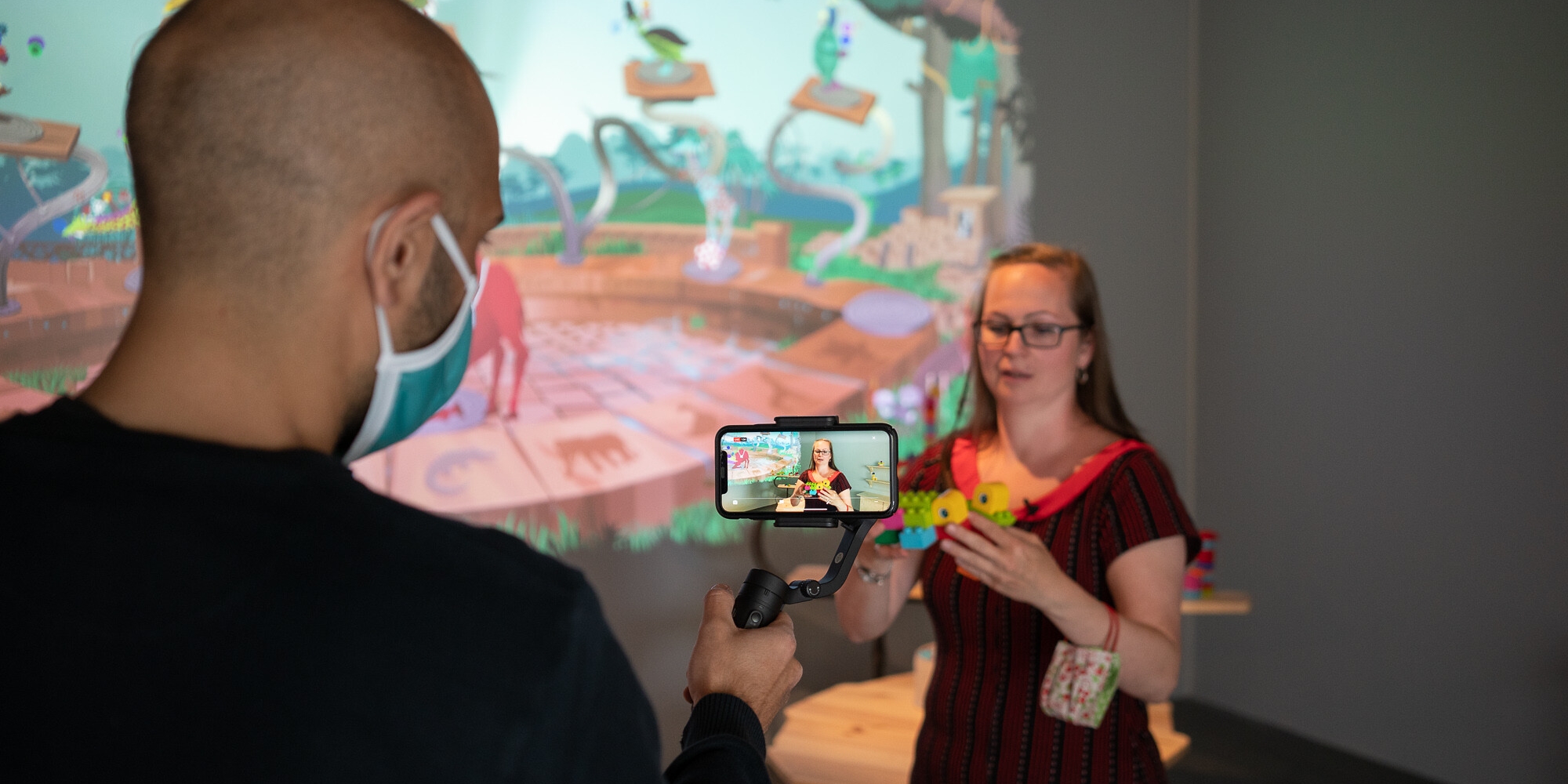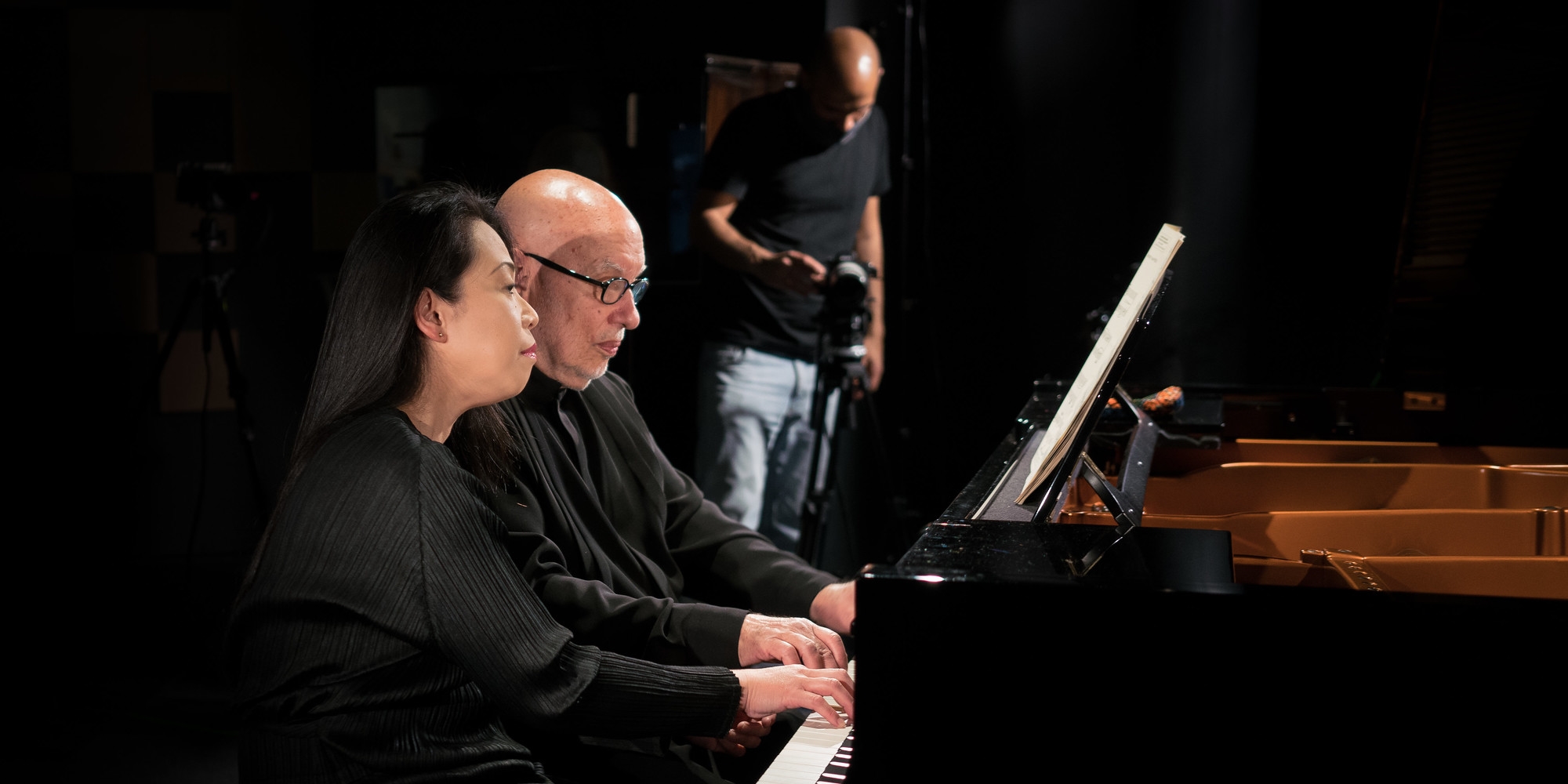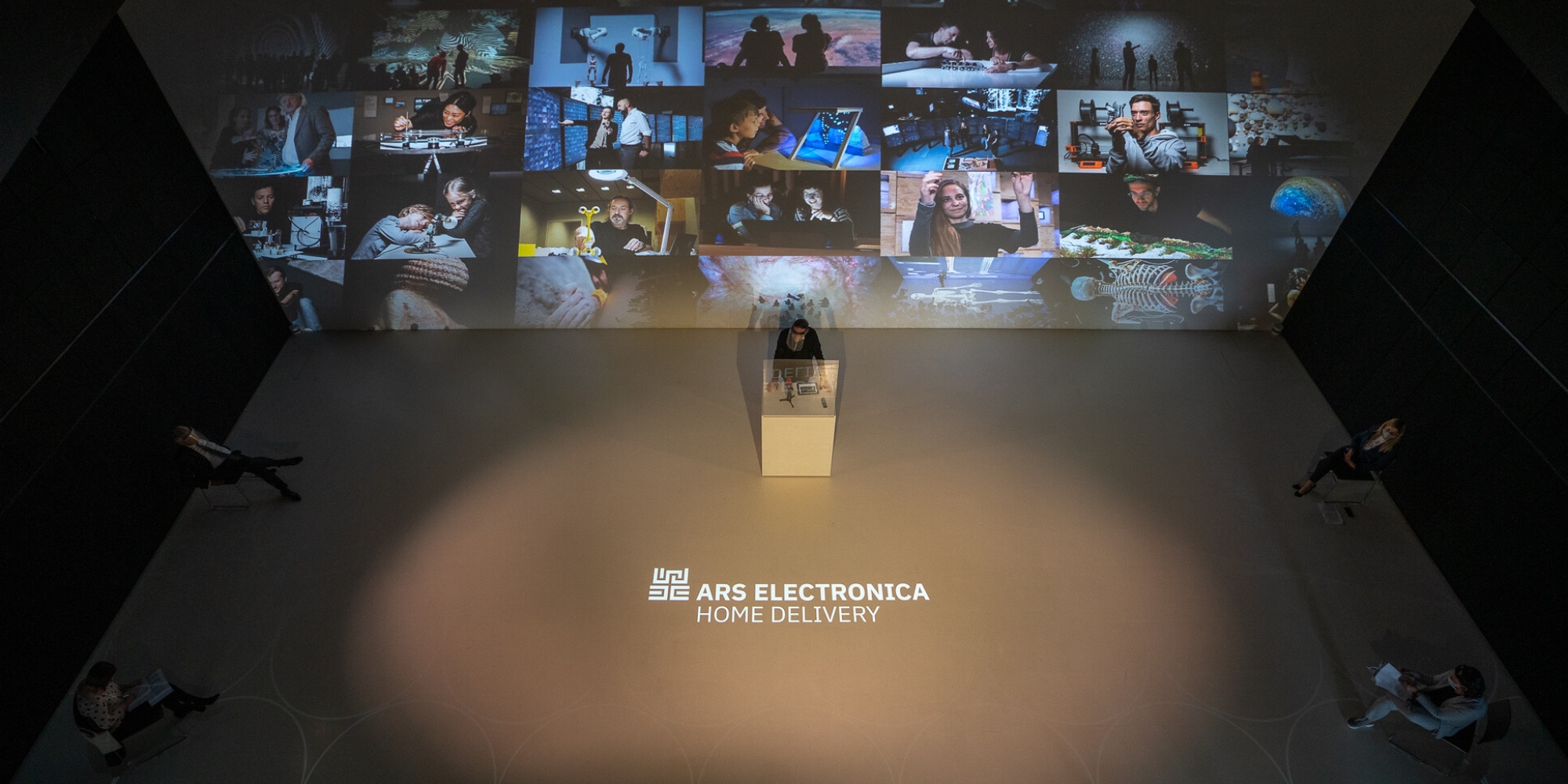In the form of live streams, which can be accessed via the Ars Electronica website and YouTube, we have been offering a weekly program since May 5. The aim is to cover the entire spectrum of the Ars Electronica Center program. The usual operation is to be maintained as “true to the original” as possible, but online. We offer guided tours of the exhibitions as well as excursions to our labs, concerts with real-time visualizations, Deep Space LIVE sessions or workshops with artists from around the world. Gerfried Stocker, Ars Electronica’s Artistic Director, explains what’s so special about the new format, why Ars Electronica Home Delivery is not museum television and why the Web in 2020 still holds a challenge compared to purely interpersonal communication.
A home delivery service by Ars Electronica – how can we imagine this?
Gerfried Stocker: Ars Electronica Home Delivery is our response to the imminent need to go back to normality, to start to deliver what museums should deliver. And museums are not only places and houses that are open for visitors again. But basically the task of a museum is to deliver content and in particular for Ars Electronica to allow people to reflect, discuss, work and reflect the content. So Home Delivery is all the regular operations of our Ars Electronica Center, but online.
We have a broad series of programs that allow people to really get access to all the interesting topics and content that we are usually presenting here in the Ars Electronica Center. We will have lectures, we will have concerts, we will have guided tours – and not just as a stream! It’s not a format where we disappear in the network, but where we emerge out of the network with a very strong live element. I think the best example are the guided tours.
Everything is not just a web page where you can click through videos about the installations, but there will be our infotrainers going through the museum, explaining the highlights of our exhibitions and even at certain points, you can express things like “I would like to see this installation / this part of the exhibition in particular. Can you explain it to me?” And the infotrainer goes there. It’s always a combination of live streaming and video conferencing so that people can really engage at a maximum level of interactivity that is possible with this digital media.
So the main difference to the existing videos of Ars Electronica is the interactivity?
Gerfried Stocker: The interactivity and the live factor. Live is the most important point, because interactivity is still limited. I mean, of course, with video conferencing you can talk. But it’s not only about the interactivity between you, sitting at home interacting with one person in the museum. Basically we are simulating the situation of the guided tours through the museum together with a group of people.
And when you have already experienced one of our guided tours, you know that sometimes you have a question and you get an answer, an explanation from the infotrainer. But maybe one of the other members of the audience has an even more interesting contribution to it or questions from other participants are suddenly inspiring you. It’s really this group dynamic of several people enjoying and experiencing the presentations here at the Ars Electronica Center – that’s what makes it special, unique. That’s the main point with guided tours, but also with the very famous lecture series of our Deep Space, with the experts from the fields of medecine, science, astronomy and of course, art and culture.

In even more detail, what can the audience expect, content wise, from Ars Electronica Home Delivery? Is there a tight schedule? Are there different formats?
Gerfried Stocker: In general the pieces will be rather short – five minutes, 10 minutes, fifteen minutes maximum. Only concerts or Deep Space lectures will be up to half an hour long. So it’s short portions that always consist of a small presentation and then the possibility to talk, to discuss, to interact with the people. And it basically goes through the whole spectrum of activities that the Ars Electronica Center is featuring anyway: We will have educational programs in particular for our young audiences, children, lots of the programs will be kind of mini courses. But again, not just a video that you click and then it’s like a tutorial video. It always has this interactive and dialogue and live situation. There will also be, of course, presentations of highlights from our cultural and artistic activities from the festivals. We will have special presentations where we also go into our archives – and imagine how many wonderful, interesting projects we have in our archive, discovering 40 years of history of Ars Electronica!
There will be different people from the various parts of Ars Electronica who are presenting special programs, for example a new research project from the Futurelab will be presented by the engineers, scientists and developers of the Futurelab. For the Prix Ars Electronica, we will do additional video conferences with, for example, jury members or artists who then together with one host from Ars Electronica are presenting the program to the audiences.

In contrary to what the public would expect web is till a challenge or let’s say a topic for Ars Electronica. Why? Why is the obvious still a challenge?
Gerfried Stocker: Well, I think when we are true to ourselves, acting in the digital space is still for most of the people a challenge. I mean, what we didn’t really recognize so clearly before is that the number of people who were really using and able to use all the digital technologies in a really kind of natural, intuitive, high level way was not so big. It’s basically only a group of experts who work as technicians or people who need to have a lot of digital interaction in their businesses. But for most of us, really going and working and acting inside the digital world was very short periods when we had a video conference once in a while with some foreign partners.
And when it’s not just browsing the web or watching streams or videos on Youtube, which is not really a digital interaction, it’s just another way of television. You click on something, you switch it on and you watch. But when it really comes to the point of interacting and in particular to interact live, not just to produce something that you deposit in the web and then somebody at another time downloads it. But when it really comes to this being together in a live situation with others but connected, this is for most of us a completely new territory. And it’s definitely a challenge because it’s completely different, when you do this on a regular basis and not just once in a while. I think it’s a particular challenge of how do we shape our communication skills and at the same time it’s a cultural technique and not just the technology. Cultural techniques have to be developed. We have to train our skills. We have to gain experiences.
And I think that’s one of the really interesting elements now of this very crazy, absurd situation that we all have to sit at home and have to keep distance. It is the biggest digitization program that ever happened in terms of bringing – with a very high speed and very short time – a huge amount of people up to date and developing the skills of acting inside this digital space. And I think this is something that is very important also for the time after Corona – because it will be a new way of living at the same time, in real and in digital spaces.

Who is the program of Ars Electronica Home Delivery addressing, and who is it designed for? Also, when we think about the future, when the museum is already open again, does it want to reach a broader audience, an audience that is farer away from Linz, maybe?
Gerfried Stocker: Yeah, well, for the beginning, actually, it is a kind of a substitute for the museum itself. We are not able to open the museum and have a meaningful way to work with people here. The way how you act as a visitor in the Ars Electronica Center is completely different to an ordinary museum where you walk around and you look at objects, paintings and things like that. In the Ars Electronica Center everything is touching and acting, close talking, discussing. So for us, it’s not really possible to make the museum in real available to the local audiences as it would be. So that’s why at the beginning we start with a service for local audiences.
But very soon we already start with programs also in English and then also in Czech language and other languages. So we are really kind of following our audiences that we had so far in the regular operations of the Ars Electronica Center in this first moment as a substitute for visiting. But then I think the nice thing is, with this program that we can smoothly phase into normal operations. We can expect that in a few weeks it will be possible to have at least maybe six to 10 people who are joining this programs, so to say as a life audience in the museum. But still, the main audience will be out there and watching our live program and I think the further this goes the more this Home Delivery will become a new layer of communication and expression of Ars Electronica for a larger international audience. But not only international in the sense of far away and in different languages. Also, when we look at the schools, we get a lot of requests from schools outside of the vicinity of Linz who are really desperately asking “Can you bring these programs to us? We cannot always afford to come visit with the whole school.” But many of our programs will be now made available through this Home Delivery service. And this will be definitely, for example, for schools in the future, a very interesting additional program. So it’s not just something that we intend to have as a short term offer for this moment of the crisis, but we are using this to develop a new format that will be a longstanding new element of Ars Electronica.

If we think even further in the future, there kind of naturally comes the question of including VR or AR – is it a topic is it about the interpersonal interaction?
Gerfried Stocker: I think at the moment for this program we are in particular trying not to make a High-Tech battle. I mean, yes, it would be so cool to have all that. But then again, the same way as here with the Ars Electronica Center the main goal here is really to to put all your effort in ways to communicate to as many as possible people. It’s not about “ii’s cool to experience things with your VR glasses”, but you have to think of the very, very low number of people who really have the equipment and are able to deal with it.
So this is anyway a group of experts and we have a lot of program for this small groups of experts. I think the real challenge is how to address the larger audiences and I think in particular now also the really interesting challenge is to re-gain this quality of live, physical human touch. And this is not retro. It’s not about going back to the good old times before everything was in social media. It’s going forward and getting out of this silo of social media and digital media, going out of it again into a next step where physical life, presence and virtual presence are not each or the other but are coming simultaneously.
And I think this is even a bigger challenge than to develop a new gadget for VR, AR or whatsoever. The much bigger challenge is really to work on these kind of social skills and these cultural techniques to gain a certain sufficient way of combining real and physical on the one side and digital on the other side.


Gerfried Stocker is a media artist and telecommunications engineer. In 1991, he founded x-space, a team formed to carry out interdisciplinary projects, which went on to produce numerous installations and performances featuring elements of interaction, robotics and telecommunications. Since 1995, Gerfried Stocker has been artistic director of Ars Electronica. In 1995-96, he headed the crew of artists and technicians that developed the Ars Electronica Center’s pioneering new exhibition strategies and set up the facility’s in-house R&D department, the Ars Electronica Futurelab. He has been chiefly responsible for conceiving and implementing the series of international exhibitions that Ars Electronica has staged since 2004, and, beginning in 2005, for the planning and thematic repositioning of the new, expanded Ars Electronica Center, which opened its doors in January 2009.
You’ve become curious and want to experience Ars Electronica Home Delivery for yourself? We invite you to take a look at our online program to learn more about our diverse program.
